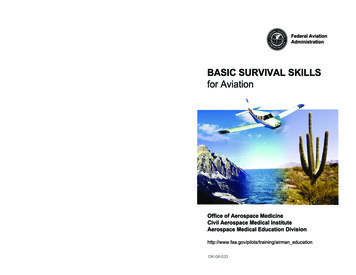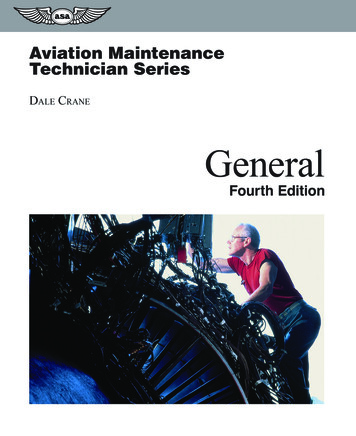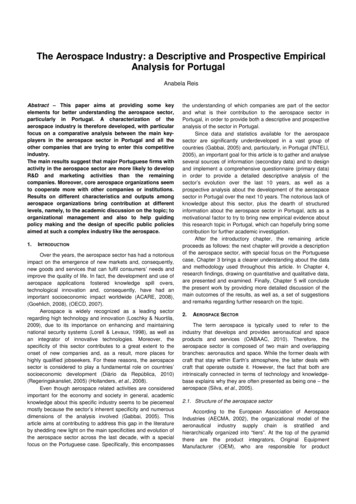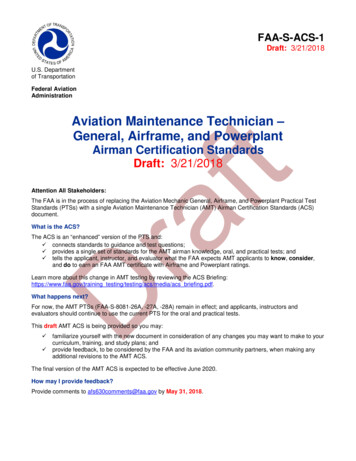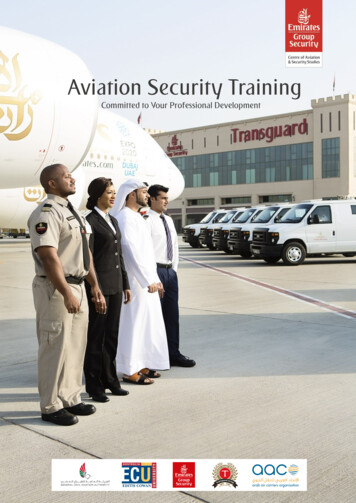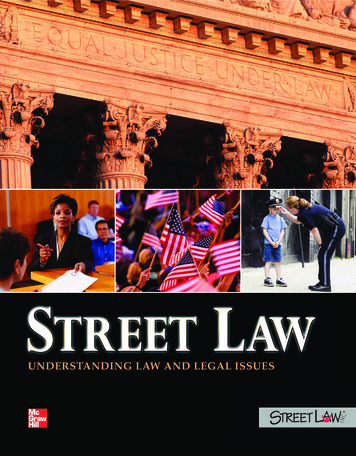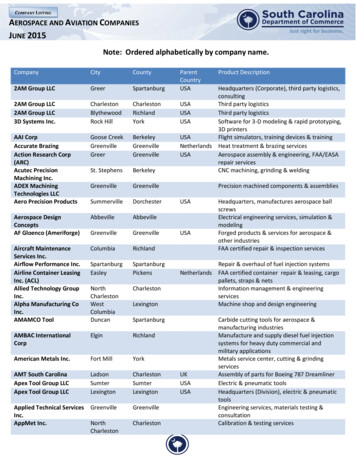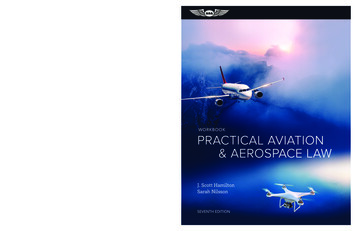
Transcription
ASAWORKBOOKPRACTICAL AVIATION& AEROSPACE LAWJ. Scott HamiltonSarah NilssonThis supporting workbook is designed to be used with the PracticalAviation & Aerospace Law textbook to provide a comprehensiveinstructional package for undergraduate and graduate aviationlaw courses offered to students preparing for aviation careers. Itaids in application of legal principles set forth in the textbookto the kinds of decisions students will make in the real world ofaviation as managers, pilots, mechanics, aircraft owners, air trafficcontrollers, air safety investigators, and others involved in aviation asa profession or hobby.HAMILTON / NILSSONThis Practical Aviation & Aerospace Law Workbook enhances thevalue of the textbook, serving as an excellent teaching tool—takentogether, the two complement each other perfectly in the classroom.Dr. Sarah Nilsson, alsowith Embry-Riddle, is anAssistant Professor and apracticing attorney in Arizona,specializing in aviation/aerospace and business law.WORKBOOKThe updated and expanded seventh edition reflects statutory andregulatory changes, including law topics surrounding the burgeoningfields of unmanned aircraft systems (UAS) and commercialspaceflight. With a concise format that mimics the textbook, thiscombination workbook/study guide breaks down a complex field oflaw into understandable examples and problems to solve—ultimatelyhelping readers retain the learned concepts. Many of the workbookquestions are based on real dilemmas faced by the authors’ clients,in their combined practices’ experience. Others are the product ofa fertile imagination.yet they give aviation law students an idea ofwhat can happen in real industry situations.Dr. J. Scott Hamilton is anAdjunct Professor and coursedeveloper at Embry-RiddleAeronautical University, whohas practiced aviation law andtaught at several colleges, andis also an experienced pilot.PRACTICAL AVIATION & AEROSPACE LAWSEVENTH EDITIONASA-PRCT-AV-WK7ASA-PRCT-AV-WK7PRACTICAL AVIATION& AEROSPACE LAWJ. Scott HamiltonSarah NilssonTMAviation Supplies & Academics, Inc.7005 132nd Place SENewcastle, Washington 98059-3153asa2fly.com 425-235-1500WORKBOOKSEVENTH EDITION
SEVENTH EDITIONWORKBOOKPRACTICAL AVIATION& AEROSPACE LAWJ. Scott HamiltonSarah NilssonAVIATION SUPPLIES & ACADEMICSNEWCASTLE, WASHINGTON
J. Scott Hamilton is an adjunct professor and course developer at Embry-Riddle Aeronautical University, formerly assistant professorand faculty chair. He previously served as general counsel for the Civil Air Patrol, then as the national organization’s chief operatingofficer. Prior to that, he served as senior assistant attorney general for the State of Wyoming. While practicing aviation law inColorado, he also was a faculty member at the University of Denver College of Law, as well as Metropolitan State College of Denver.He is an experienced pilot and skydiver who served as a HALO instructor in the Green Berets. Hamilton is widely published onaviation law and has received many honors, including induction into the Colorado and Arkansas Aviation Halls of Fame.Sarah Nilsson is an Assistant Professor at Embry-Riddle Aeronautical University and a practicing attorney in Arizona, where herpractice focuses on aviation/aerospace and business law. She previously managed an Aerospace magnet program at an inner-city highschool in Phoenix. Nilsson gained extensive aviation operating experience working as a cargo pilot and flight instructor and nowvolunteers as a safety representative on the FAA Safety Team. Her research interests include aviation, space, and unmanned aircraftsystems law.In 2017, Sarah published Drones Across America with the American Bar Association, a textbook devoted to Federal, State andlocal unmanned aircraft regulations, laws, and ordinances. Since 2015, she has been interviewed by news media on TV and radioand has presented at numerous conferences and symposia across the nation for The Citadel, the Arizona Attorney General’s Office,Arizona Geographic Information Council, and the Air and Space Law Forum of the American Bar Association, to name a few.Practical Aviation & Aerospace Law Workbook, Seventh EditionJ. Scott Hamilton, Sarah Nilsson 2020 Aviation Supplies & Academics, Inc.All rights reserved.Seventh Edition published 2020 by ASA.Aviation Supplies & Academics, Inc.7005 132nd Place SENewcastle, WA 98059Email: asa@asa2fly.comWebsite: www.asa2fly.comCover: bigstockphoto.com denbelitskyASA-PRCT-AV-WK7ISBN 978-1-64425-032-7Additional formats available:KindleISBN 978-1-64425-034-1eBook ePub ISBN 978-1-64425-033-4eBook PDF ISBN 978-1-64425-035-8eBundleISBN 978-1-64425-036-5 (print eBook PDF download code)Printed in the United States of America2024022023202220212020987654321
CONTENTSPreface vPART I123ADMINISTRATIVE LAWRegulatory Agencies and International OrganizationsFAA Enforcement 9Aviation Medical Cases 20PART II45678910AIRCRAFT ACCIDENTSBasic Principles of Civil Liability 27Organizing the Business to Limit Liability 33Aviation Insurance 38Exculpatory Contracts 45Airline Liability 48Government Liability 52Accident Notification, Reporting and Investigation356PART III AIRCRAFT TRANSACTIONS11 Buying and Selling Aircraft 6512 Aircraft Leasing, Co-Ownership and Fractional OwnershipPART IV13141568AIRPORTS, AIRSPACE, AND AVIATION SECURITYAirports and Terminal Airspace 73FAA Regulation of Airspace 79Crimes, Civil Offenses, and Aviation Security 82PART V LABOR AND EMPLOYMENT LAW16 Labor and Employment Law, Generally17 Air Carrier Labor Law 9691PART VI EVOLVING LAW18 Commercial Spaceflight Operations 10519 Unmanned Aircraft Systems Operations 109iii
PREFACEThis WORKBOOK is designed to be used with the textbook Practical Aviation & Aerospace Law,Seventh Edition, in aviation and aerospace law courses offered to students preparing for careers inthe aviation and aerospace industries. It helps you practice applying the legal principles discussedin the text to the kinds of decisions you will be making in the “real world” of aviation and aerospaceas business and airport managers, pilots, maintenance personnel, air traffic controllers, securitypersonnel, and the like.Many of the workbook questions are based on real dilemmas our clients have faced over theyears, while others are the product of a fertile imagination. In the classroom or online, yourprofessor may introduce hypothetical changes to the facts given here, challenging you to analyzethe effects that changes in facts (sometimes subtle) have on strategies and outcomes, and maybring particular, actual cases into the discussion.This edition of the workbook also adds some suggested online research assignments thatyour professor may assign, usually to either explore changes that may occur after the textbook ispublished, or to take a more global view of the particular topic.Because the workbook is closely keyed to the text, we suggest that as soon as you have read achapter in the text, you work through the workbook questions on that chapter while it is fresh inyour mind.v
PART IAdministrative Law
1REGULATORY AGENCIES ANDINTERNATIONAL ORGANIZATIONSReview Questions1. You are the human resources director for a regional U.S. airline. One of your dutiesincludes screening new pilots and maintenance personnel applying for jobs with theairline. As part of the process, your staff should check the FAA’s records on each applicant’scertificates, ratings, accident history, and FAR violation history. Where would they find thisinformation?2. You are an engineer for an avionics company that is designing a new navigational system forcivil aviation use. What organization establishes the technical specifications for radio aids tonavigation? In what series of publications would you look to find these specifications?3. Your aircraft has been involved in an accident. What agency or agencies will investigate theaccident? What agency will determine the probable cause of the accident?4. An agency of the U.S. government is presently experimenting with and assisting in thedevelopment of technical standards for the components of the next generation air trafficcontrol system (NextGen). What agency is responsible for that work, and where is it beingcarried out?3
5. An agency of the U.S. government is conducting research and experimentation on methodsfor detecting airframe ice and conveying the information to the flight crew in a usefulformat. What agency would be responsible for such experimentation? If that research andexperimentation leads to a new technology, what agency of the U.S. government wouldestablish the airworthiness standards for incorporating that technology into U.S. civil aircraft?6. An emerging nation wishes to enter into an agreement with the United States to facilitateregular airline service between the two nations. Which of the so-called “five freedoms of theair” would this involve? What agency of the U.S government would it deal with to negotiatea treaty to provide such service? Once the treaty has been negotiated, is any further actionby the U.S. government required to bring it into effect?7. The treaty (discussed above) providing for reciprocal air service is now in effect. The othernation wishes to designate its new national airline to provide a portion of the serviceunder that agreement. Does the U.S. government have any say whether that airline will bepermitted to provide that service to the United States? If so, how?8. What has proved to be the most intractable problem facing international civil aviation onwhich to gain global agreement? Why?9. Does the National Transportation Safety Board (NTSB) have any aviation responsibilitiesnot relating directly to aircraft accidents? If so, describe.10. Does the National Aeronautics and Space Administration (NASA) have any aviationresponsibilities other than technological and aerodynamic research and development?If so, describe.4 PART I ADMINISTRATIVE LAW
11. What are the powers of the Civil Aeronautics Board (CAB) today?12. To what extent, if any, may state governments regulate the routes served and rates chargedby airlines?13. Which agency of the U.S. government regulates labor relations in the airline industry?14. What authority, if any, does the National Labor Relations Board (NLRB) have over laborrelations in:a. The airline industry?b. Aerospace manufacturing?c. General aviation?15. Which agency of the U.S government has the primary responsibility for regulating aviationsafety?16. Describe and distinguish FAA and NASA responsibilities in regulating commercialspaceflight operations.CHAPTER 1 REGULATORY AGENCIES AND INTERNATIONAL ORGANIZATIONS 5
17. Distinguish U.S. Customs and Border Protection (CBP) responsibilities from those ofImmigration and Customs Enforcement (ICE).18. You want to determine who owns a particular aircraft. Which agency of the U.S.government would have that information, and where would it be found?19. Until Congress passed and the president signed the Airline Deregulation Act of 1978,which agency of the U.S. government regulated airline economics (routes served and ratescharged)?20. Which agency or agencies of the U.S. government operate radio aids to air navigation?21. Are there any privately owned and operated radio aids to navigation in the United States?22. If the FAA and its counterpart agencies in other nations were interested in collaboratingto make civil aircraft certification standards globally uniform, what organization wouldlogically coordinate that effort? Where is that organization headquartered?23. Why did the nations represented at the 1944 Chicago Conference not agree to the “fivefreedoms of the air” then proposed by the United States? If a similar conference were heldtoday, do you think the international community would take the same position? Why?6 PART I ADMINISTRATIVE LAW
24. Which agency of the U.S. government and which office of that agency is responsible for theproduction of aeronautical charts?25. NASA research relating to general aviation focuses on what areas?26. Which agency of the U.S. government is responsible for the day-to-day screening of airlinepassengers, baggage, and cargo?27. That agency is now included in what federal department?28. Is the regulation of workplace safety and health conditions in the U.S. preempted (regulatedexclusively by) the federal government, or do the states have a role?29. What federal agency is responsible for assuring the coordination and sharing of intelligencerelating to threats against transportation?30. What federal agency and what office of that agency is responsible for screening foreignapplicants to U.S. flight schools for security risks?CHAPTER 1 REGULATORY AGENCIES AND INTERNATIONAL ORGANIZATIONS 7
SEVENTH EDITIONWORKBOOKPRACTICAL AVIATION& AEROSPACE LAWJ. Scott HamiltonSarah NilssonPracticalAviation & Aerospace Law textbook to provide a comprehensiveinstructional package for undergraduate and graduate aviationaids in application of legal principles set forth in the textbookto the kinds of decisions students will make in the real world ofcontrollers, air safety investigators, and others involved in aviation asa profession or hobby.regulatory changes, including law topics surrounding the burgeoninglaw into understandable examples and problems to solve—ultimatelyhelping readers retain the learned concepts. Many of the workbookquestions are based on real dilemmas faced by the authors’ clients,in their combined practices’ experience. Others are the product ofa fertile imagination.yet they give aviation law students an idea ofwhat can happen in real industry situations.Practical Aviation & Aerospace Law Workbook enhances thevalue of the textbook, serving as an excellent teaching tool—takentogether, the two complement each other perfectly in the classroom.TMAviation Supplies & Academics, Inc.7005 132nd Place SENewcastle, Washington 98059-3153asa2fly.com 425-235-1500Dr. J. Scott Hamilton is anAdjunct Professor and coursedeveloper at Embry-RiddleAeronautical University, whohas practiced aviation law andtaught at several colleges, andis also an experienced pilot.Dr. Sarah Nilsson, alsowith Embry-Riddle, is anAssistant Professor and apracticing attorney in Arizona,specializing in aviation/aerospace and business law.
PRACTICAL AVIATION questions are based on real dilemmas faced by the authors’ clients, & AEROSPACE LAW SEVENTH EDITION WORKBOOK J. Scott Hamilton . PART IV AIRPORTS, AIRSPACE, AND AVIATION SECURITY 13 Airports and Terminal Airspace 73 14 FAA Regulation of Airspace 79 15 Crimes, Civi

